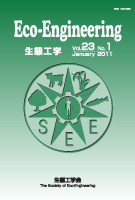All issues

Volume 23 (2011)
- Issue 4 Pages 101-
- Issue 3 Pages 75-
- Issue 2 Pages 41-
- Issue 1 Pages 3-
Predecessor
Volume 23, Issue 1
Displaying 1-4 of 4 articles from this issue
- |<
- <
- 1
- >
- >|
Original papers
-
Norimi Takata2011 Volume 23 Issue 1 Pages 3-10
Published: January 31, 2011
Released on J-STAGE: June 02, 2011
JOURNAL FREE ACCESSThe port of Fukuyama is located in the Bingo-nada, the central area of the Seto Inland Sea, and is an area of semienclosed coastal waters. In the interior part of the port, dissolved oxygen (DO) in the bottom layer decreased to nothing in June. The low DO condition continued until October, and the period of low DO coincided with a period of high water temperature. This study aimed to clarify the characteristics of benthic fauna in the port of Fukuyama in relation with low DO conditions. In 1998–1999, we carried out an investigation to clarify the number of species, density, biomass, and diversity of macrobenthos inhabiting the port. The macrobenthic fauna was composed of 111 species with 50% of polycheates, 28% of crustaceans and 14% of bivalves. A small-size polychaete community inhabited the inner part of the port, polycheate and bivalve communities were distributed in the mouth of the port, and an intermediate community composed of both communities lived in the central part of the port. These habitat segregations of communities of macrobenthos reflected the conditions of DO in the bottom layer and sediment.View full abstractDownload PDF (675K) -
Toshiharu Yanagawa, Toyoki Kawabata, Nakahiro Iwata, Kotaro Kikuchi2011 Volume 23 Issue 1 Pages 11-16
Published: January 31, 2011
Released on J-STAGE: June 02, 2011
JOURNAL FREE ACCESSA feeding experiment was carried out for tiger puffer, Takifugu rubripes, with a recirculating aquaculture system of 37 m3 in total water volume. The system consisted of a fish tank of 27 m3 culture water, drum screen filter, submerged biofilter, temperature control unit, oxygen and air generator and diffusers, and UV sterilizer. Underground seawater of salinity 23 ppt after filtered through 25 μm porous media and UV treatment was used as culture water with daily exchange of 2 m3 to keep nitrate level under 100 mg-N/L. At the start of the experiment, 1,000 fish of 6.9 g in average body weight were introduced to the fish tank and fed commercial pellet once to three times daily. Fish grew to an average weight of 960 g after 490 days of rearing with good survival rate of 90%. Total fish weight in the system was 850 kg, and the final stocking density per unit water volume in the culture tank reached to 30 kg/m3 at the end. Nitrification operated successfully and ammonia and nitrite of the rearing water were maintained less than 2 mg-N/L almost through the experimental period. These results demonstrate that tiger puffer can be effectively produced in low saline seawater recirculation system with partial exchange of culture.View full abstractDownload PDF (329K) -
Kazushige Nakabayashi, Yuki Tsuboi, Yuji Ogura2011 Volume 23 Issue 1 Pages 17-23
Published: January 31, 2011
Released on J-STAGE: June 02, 2011
JOURNAL FREE ACCESSIn recent years, sea lettuce (Ulba sp.) has increased in abundance and distribution. Seaweed washed ashore causes problems, not only because it detracts from the coastal scenery but also because it damages coastal ecosystems and its decomposition generates an offensive odor. However, with its high alginic acid and mineral contents, sea lettuce has been recently used in the manufacture of glues and ash. If sea lettuce, which is also rich in minerals such as nitrogen and phosphorus, could be used as a fertilizer for feed crops, the coastal environment would be beautified through removal of sea lettuce, and the livestock industry would be supported through feed crop production. In this study, we compared the effects of applying dried sea lettuce fertilizer, fermented sea lettuce fertilizer and a chemical fertilizer on the production of cultivated corn. The results showed that sea lettuce fertilizer could be mixed with farmland soil at a rate of 1—2 t/10 a. Sea lettuce fertilizer should be applied intermittently to avoid long-term repeat cultivation. These findings show that sea lettuce fertilizer could replace a large quantity of the chemical fertilizer currently applied to feed crops.View full abstractDownload PDF (475K)
Short communication
-
Kazuhiko Moriya, Ryozo Noguchi, Takahiro Saito2011 Volume 23 Issue 1 Pages 25-30
Published: January 31, 2011
Released on J-STAGE: June 02, 2011
JOURNAL FREE ACCESSWaste treatment affects the basis of closed materail circulation system. In choosing and evaluating waste treatment methods for closed materail circulation system, we need objective source and judgmental standard for that system. The weight putting of objective data is done based on someone's subjectivity and sense, and there is AHP (Analytic Hierrarchy Process) in one of the methods of supporting the decision making. In this paper, the waste system for closed material circulation system was evaluated by using AHP Application. According to the weighting that to think treating time and recovery rate of nutrient are more important than energy consumption, Wet Oxidation was better waste treatment methods for closed material circulation system than Anaerobic Fermentation. The result of sensibility analysis the weighting, to convert importance of treating time was easier than that of energy for select Anaerobic Fermentation.View full abstractDownload PDF (352K)
- |<
- <
- 1
- >
- >|